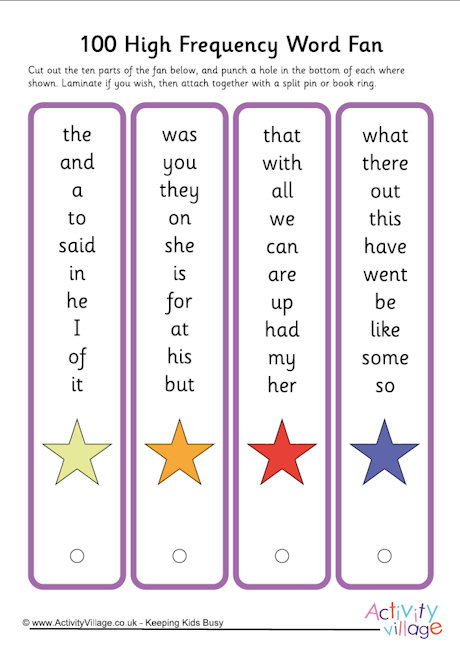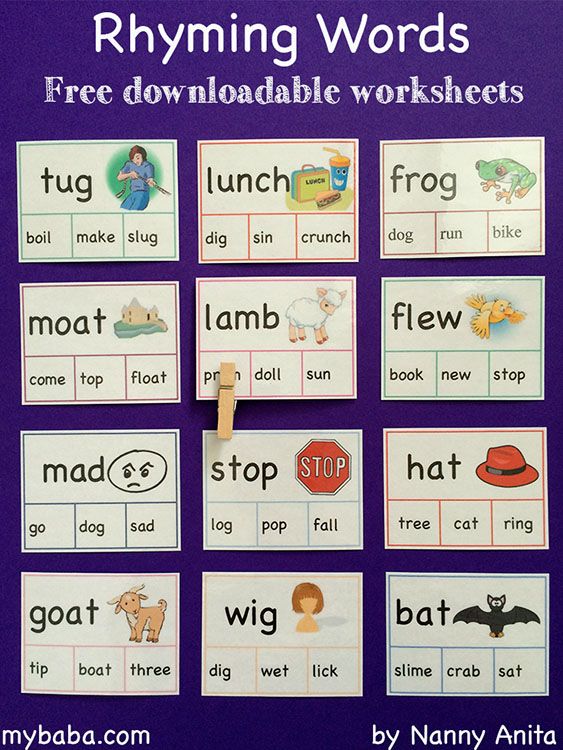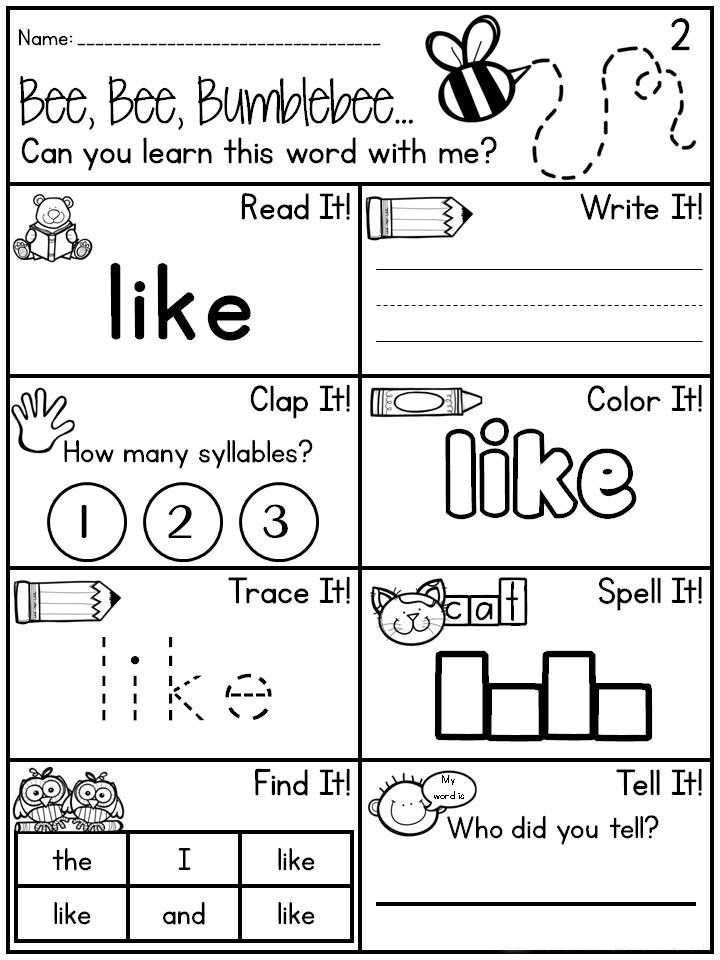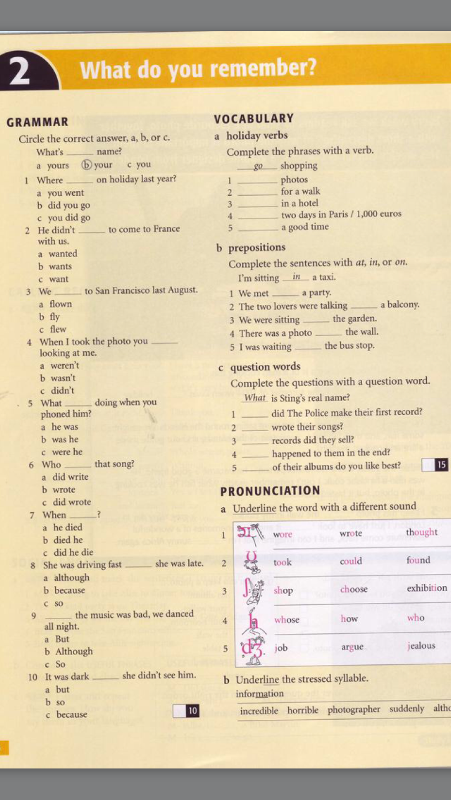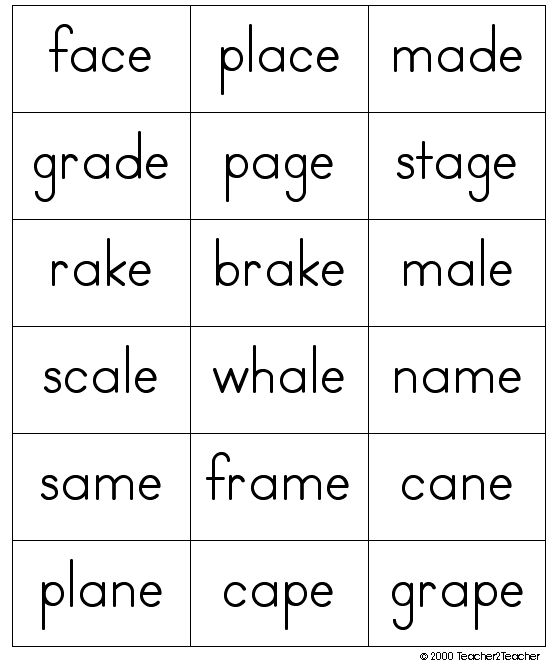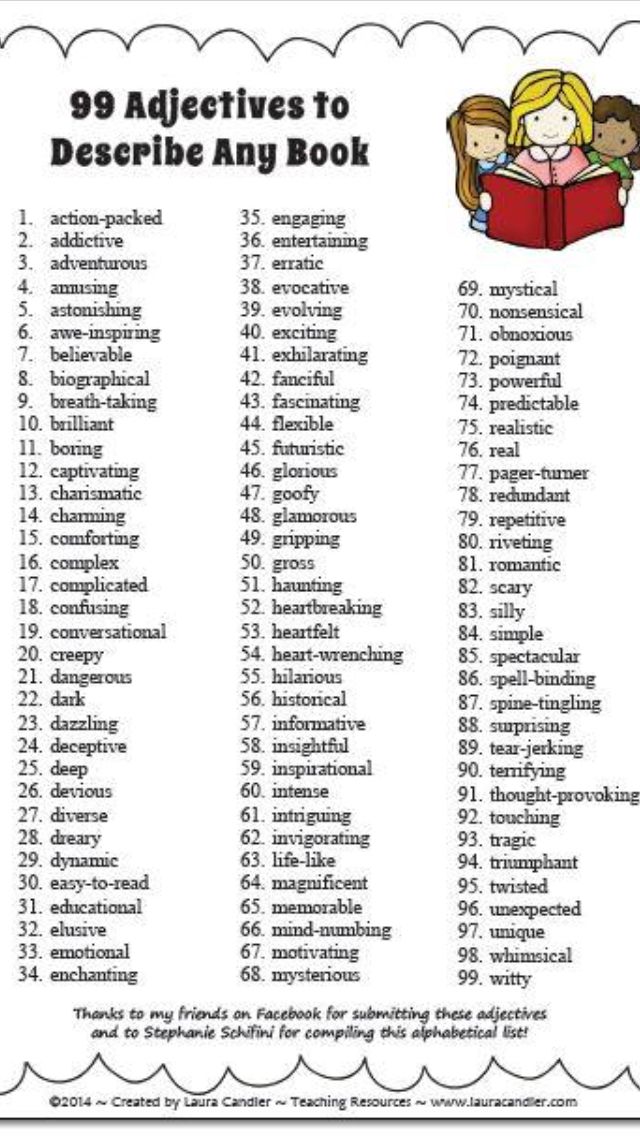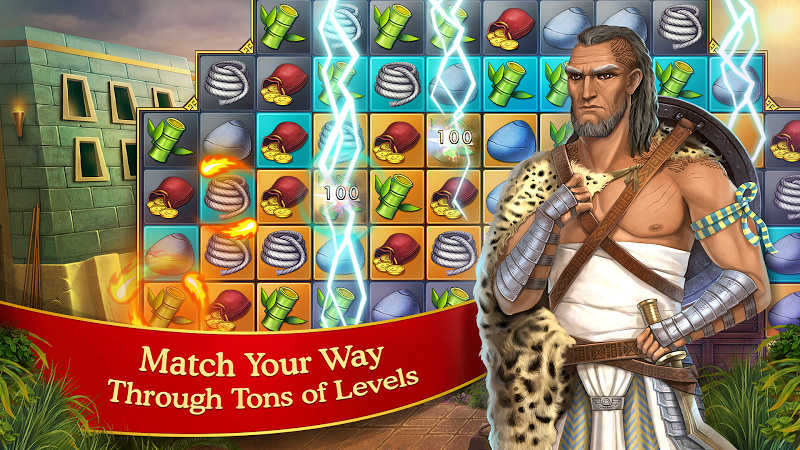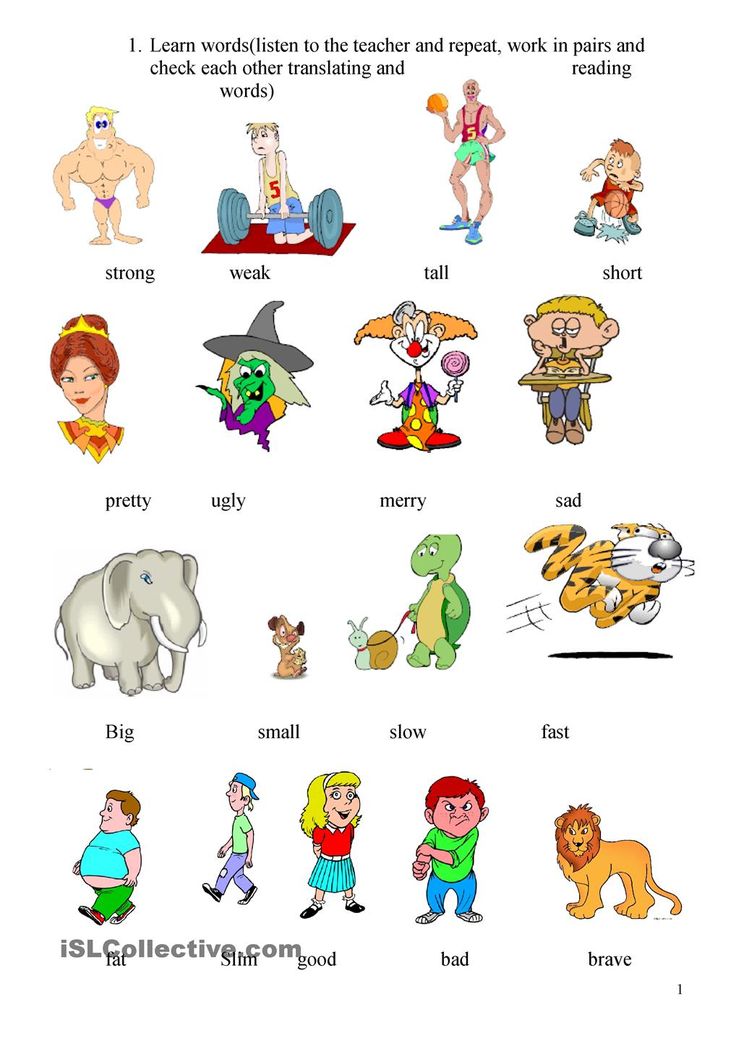High frequency words
A New Model for Teaching High-Frequency Words
We have visited many schools to observe intervention lessons and core reading instruction. For years we have been struck that even schools embracing research-based reading instruction teach high-frequency words through rote memorization. It is as if the high-frequency words are a special set of words that need to be memorized and can’t be learned using sound–symbol relationships.
A number of years ago, a teacher we respect enormously asked for help because many of her Tier 2 students and all of her Tier 3 students in first and second grades were failing to learn high-frequency words, even though they were progressing in their phonics lessons. We observed her teaching the digraph th to a group of four Tier 3 first grade students. This lesson was in April. Her students had learned to read CVC words and this was their first lesson with digraphs. The high-frequency words the students were responsible for knowing in this lesson were the color words:
blue, red, yellow, orange, purple, and green. None of the four students could spell more than two of the words accurately. All four students had difficulty reading those words when they were mixed into lists with other high-frequency words. (Indeed, they were having difficulty reading all the high-frequency words in the lists.)
These students could read words that followed spelling patterns they had learned and practiced, but they struggled learning words that made no sense to them from a sound–spelling viewpoint. We suggested that the students learn high-frequency words according to spelling patterns, and not according to frequency number or theme.
Together with the teacher, we organized the high-frequency words to fit into the phonics lessons so that the words were tied to spelling patterns students were learning. First, we focused on identifying decodable high-frequency words such as but, him, and yes and integrating them into phonics lessons instead of teaching them as words that had to be memorized.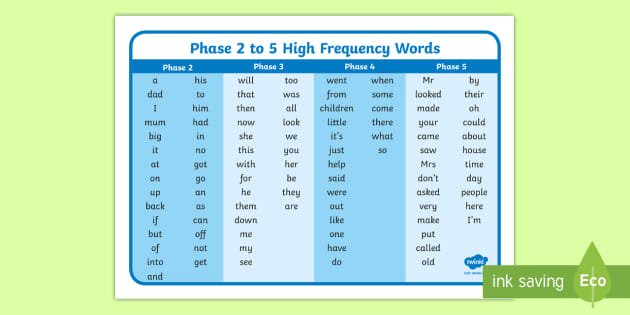 Next, we identified irregularly spelled high-frequency words such as
said, you, and from. These words have two or three letter sounds students knew and only one or two letters that had to be memorized. We integrated 2 or 3 of these words into a phonics lessons, and students learned to identify the letters spelled as expected and to learn “by heart” the letters not spelled as expected.
Next, we identified irregularly spelled high-frequency words such as
said, you, and from. These words have two or three letter sounds students knew and only one or two letters that had to be memorized. We integrated 2 or 3 of these words into a phonics lessons, and students learned to identify the letters spelled as expected and to learn “by heart” the letters not spelled as expected.
With this approach, students had an easier time learning to read the word said because they knew that only the letters ai are an unexpected spelling. Students also soon stopped confusing was and saw because they learned to think about the first sound before reading or spelling those words. The teacher told us that she, her students, and their parents were thrilled that they were no longer “banging their heads against the wall” going over and over the words as students tried to memorize how to read or spell high-frequency words with little success.
Current practices
High-frequency words are often referred to as “sight words”, a term that usually reflects the practice of learning the words through memorization.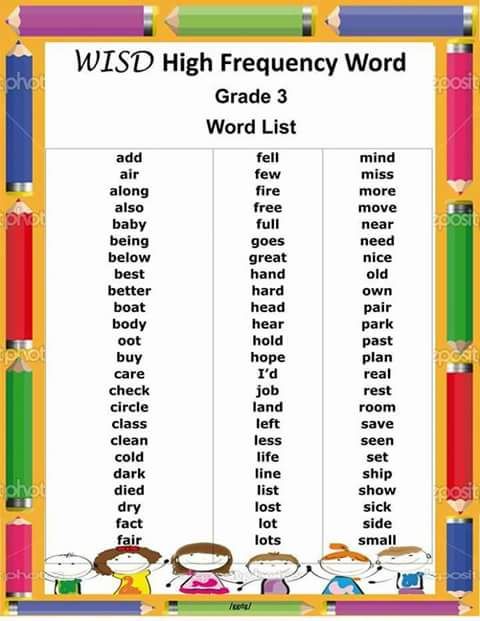 These words might be on the Dolch List, Fry Instant Words, or selected from stories in the reading program. Common practice often includes sending these “sight words” home for students to study and memorize, or drilling with flash cards in school. Students may start with word #1 and progress through the words in the order of frequency. Some teachers, like our friend above, group the words in categories, such as numbers or colors, whenever possible. In essence, high-frequency word instruction is often fully divorced from phonics instruction. While this method works for many students, it is an abysmal failure with others.
These words might be on the Dolch List, Fry Instant Words, or selected from stories in the reading program. Common practice often includes sending these “sight words” home for students to study and memorize, or drilling with flash cards in school. Students may start with word #1 and progress through the words in the order of frequency. Some teachers, like our friend above, group the words in categories, such as numbers or colors, whenever possible. In essence, high-frequency word instruction is often fully divorced from phonics instruction. While this method works for many students, it is an abysmal failure with others.
Overview of suggested restructuring
Integrating high-frequency words into phonics lessons allows students to make sense of spelling patterns for these words. To do this, high-frequency words need to be categorized according to whether they are spelled entirely regularly or not. Restructuring the way high-frequency words are taught makes reading and spelling the words more accessible to all students. The rest of this article describes how to “rethink” teaching of high-frequency words and fit them into phonics lessons.
The rest of this article describes how to “rethink” teaching of high-frequency words and fit them into phonics lessons.
Teach 10–15 “sight words” before phonics instruction begins
Many kindergarten students are expected to learn 20 to 50, or even more, high-frequency words during the year. The words are introduced and practiced in class and students are asked to study them at home. Learning these “sight words” often starts before formal phonics instruction begins.
Children do need to know about 10–15 very-high-frequency words when they start phonics instruction. However, these words can be carefully selected so that they are the “essential words” that are not decodable when the short vowel patterns VC and CVC are taught. Words such as at, can, and had are easier for students to learn using phonics than by simply memorizing them.
We recommend teaching 10–15 pre‐reading high-frequency words only after students know all the letter names, but before they start phonics instruction.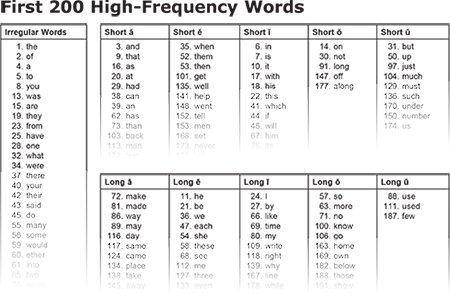 (Students who have not learned their letter names inevitable struggle to learn words that have letters they cannot identify.) Teaching students to read the ten words in Table 1 as “sight words” even before they begin phonics instruction is unlikely to overburden even “at risk” students. These ten words can be used to write decodable sentences when phonics instruction begins. The words in Table 1 are suggestions only, and teachers may revise or add words based on their reading materials and their students. For example, the words are and said are often added.
(Students who have not learned their letter names inevitable struggle to learn words that have letters they cannot identify.) Teaching students to read the ten words in Table 1 as “sight words” even before they begin phonics instruction is unlikely to overburden even “at risk” students. These ten words can be used to write decodable sentences when phonics instruction begins. The words in Table 1 are suggestions only, and teachers may revise or add words based on their reading materials and their students. For example, the words are and said are often added.
To teach these ten pre-reading sight words, we recommend introducing one word at a time. Teaching these words in the order listed can minimize confusion for students. For example, the and a are unlikely to be confused, as are I and to. However, to and of are widely separated on the table because both are two-letter words with the letter o, and t and f have similar formations.
As we recommended above, the words in Table 1 should not be taught or practiced until a student knows all the letter names.
Students can demonstrate they know these words in a number of ways, including (1) finding the word in a list or row of other words, (2) finding the word in a text, (3) reading the word from a card, and (4) spelling the word.
If students know letter sounds and can identify the first sound in a word, the following words can be tied to beginning letter sounds because the initial sound is spelled as expected: to, and, was, you, for, is. The word I is easily recognized by students who know their letter names. On the other hand, the words the, a, and of cannot be tied to known letter sounds.
Teaching a “ditty” to help students learn the, a, and of works for many students. Teachers have had success teaching students to sing the ditties below. It is important that students have the word in front of them when they say the ditty.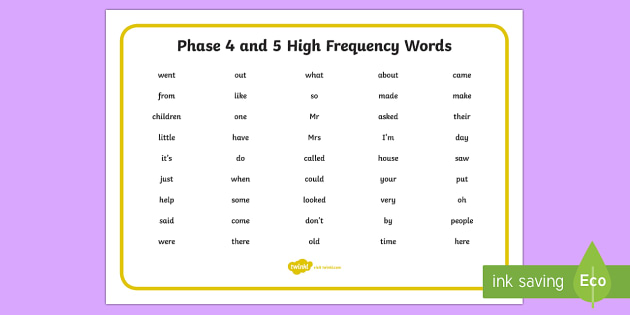 They should point to the word when they say it in the ditty, and point to the letters when they say them in the ditty.
They should point to the word when they say it in the ditty, and point to the letters when they say them in the ditty.
- The: I can say ‘thee’ or I can say ‘thuh’, but I always spell it ‘t’ ‘h’ ‘e’
- A: I can say ‘ā’ or I can say ‘uh’, but I always spell it with the letter ‘a’
- Of is hard to spell, but not for me. I love to spell of. ‘o’ ‘f’ of, ‘o’ ‘f’ of, ‘o’ ‘f’ of
Table 1: 10 Sight Words for Pre-Readers to Learn
| Word | Dolch Frequency Rank | Fry Frequency Rank |
|---|---|---|
| the | 1 | 1 |
| a | 5 | 4 |
| I | 6 | 20 |
| to | 2 | 5 |
| and | 3 | 3 |
| was | 11 | 12 |
| for | 16 | 13 |
| you | 7 | 8 |
| is | 22 | 7 |
| of | 9 | 2 |
Dolch words are from: Dolch, E. W. (1936). A basic sight vocabulary. The Elementary School Journal, 36(6), 456-460.
W. (1936). A basic sight vocabulary. The Elementary School Journal, 36(6), 456-460.
Dolch Rankings were found on lists at K12 Reader and Mrs. Perkins Dolch Words.
Fry words and rankings are from: Fry, E., & Kress, J.K. (2006). The Reading Teacher’s Book of Lists. Jossey-Bass: San Francisco.
Flash Words and Heart Words defined
For instructional purposes, high-frequency words can be divided into two categories: those that are phonetically decodable and those with irregular spellings. We call high-frequency words that are regularly spelled and thus decodable “Flash Words”.
Although their spelling patterns are easily decoded, Flash Words are used so frequently in reading and writing that students need to be able to read and spell them “in a flash”. Examples of Flash Words at the cvc level are can, not, and did. Irregularly spelled words are called “Heart Words” because some part of the word will have to be “learned by heart.” Heart Words are also used so frequently that they need to be read and spelled automatically.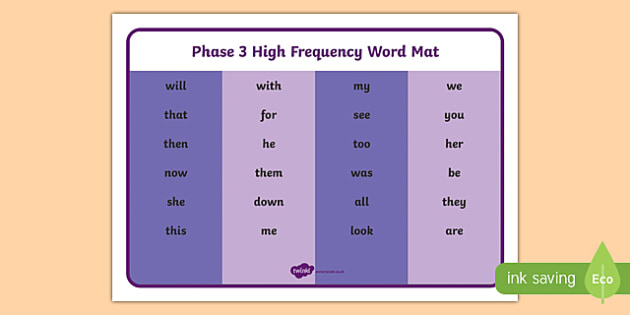 Examples of Heart Words are: said, are, and where.
Examples of Heart Words are: said, are, and where.
Words on any high-frequency word list can easily be categorized into Flash Words and Heart Words. However, be cautioned that a word may change categories. For example, early in a phonics scope and sequence, see may be a Heart Word because the long e spelling patterns haven’t been taught. When students learn that ee spells long e, see becomes a Flash Word. Further, many of the Heart Words can be categorized into words with similar spellings. This article categorizes words on the Dolch List of 220 High Frequency Words (Dolch 220 List)1. The method we use to categorize words on the Dolch 220 List works with any high-frequency word list.
Flash Words
One hundred and thirty-eight words (63%) on the Dolch 220 List are decodable when all regular spelling patterns are considered. Tables 2A, 2B, and 2C show the 138 decodable words categorized by spelling patterns.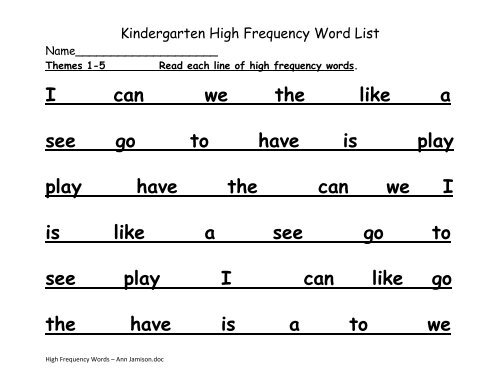 These tables can help teachers determine when to introduce the words during phonics lessons. Table 2A may be most useful for teachers of beginning reading because it lists the 60 one-syllable decodable words with the short vowel spelling pattern.
These tables can help teachers determine when to introduce the words during phonics lessons. Table 2A may be most useful for teachers of beginning reading because it lists the 60 one-syllable decodable words with the short vowel spelling pattern.
Table 2A: Flash Words (Decodable Words)
60 One-Syllable Words with Short Vowel Spelling Patterns
(Numbers in parentheses are the Dolch frequency ranking)
| VC | CVC | Digraphs | Blends | Words Ending in NG and N |
|---|---|---|---|---|
| (Sorted by vowel spelling) | (Sorted by vowel spelling) | (Sorted by digraph) | (Sorted by ending blends, then beginning blends) | (Sorted by ending letters) |
| at (21) | had (20) hot (203) | that (14) | and (3) | sing (213) |
| am (37) | can (42) but (19) | with (23) | just (78) | bring (155) |
| an (72) | ran (111) run (163) | then (38) | must (149) | long (167) |
| it (8) | him (22) cut (188) | them (52) | fast (182) | thank (216) |
| in (10) | did (45) get (51) | this (55) | best (210) | think (110) |
| if (65) | will* (59) yes (60) | much (142) | went (62) | drink (159) |
| on (17) | big (61) red (80) | pick (185) | ask (70) | |
| off* (132) | six (120) well* (109) | wish (217) | its (75) | |
| up (24) | sit (191) let (112) | when (44) | jump (98) | |
| us (169) | not (49) tell (141) | which (192) | help (113) | |
| got (93) ten (153) | stop (131) | |||
| black (151) |
*Students easily understand that two consonants at the end of a word spell one sound.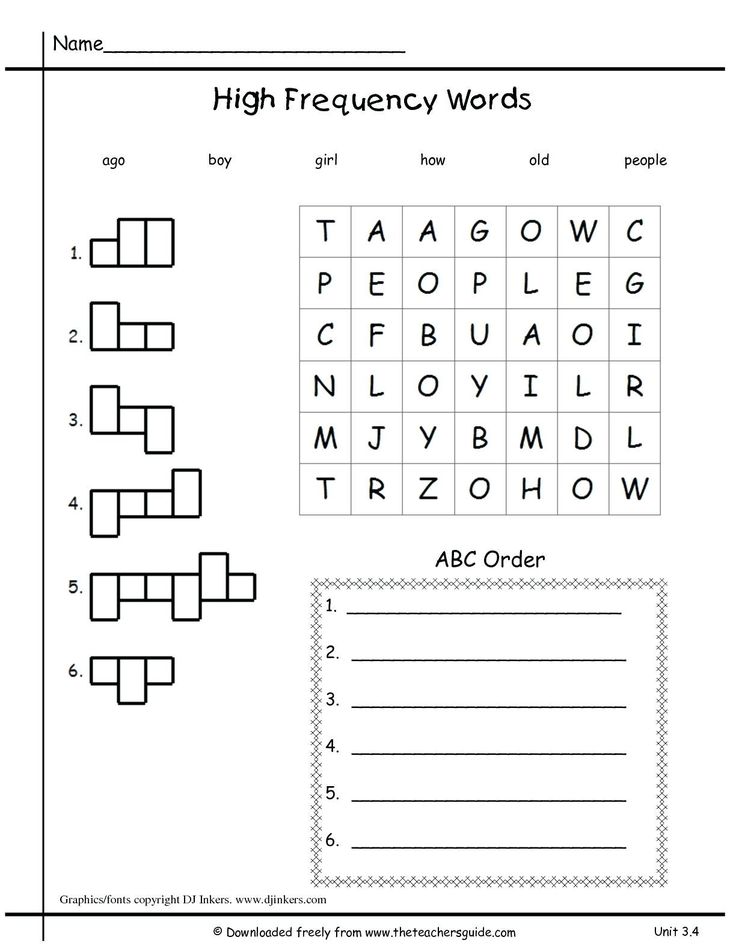
1The source for words on the Dolch 220 List is: Dolch, E. W. (1936). A basic sight vocabulary. The Elementary School Journal, 36(6), 456-460. Tables in this article show frequency rankings for words on the Dolch 220 list. Rankings for words on the Dolch 220 List can be found in many places, but we did not find a primary source that can be attributable to Dr. Dolch.
Rankings were retrieved on March 15, 2013, from K12 Reader and Mrs. Perkins Dolch Words.
Flash Words that can be taught with spellings students know will vary at any given time, depending on which phonics patterns students have been taught. For example, the words had, am, and can will be decodable when students have learned short a and vc and cvc spelling patterns. That, when, pick, and much will be decodable after students learn digraphs and can read words with digraphs. The words just, went, black, and ask will be decodable when students learn to read words with blends.
Flash Words should be introduced when they fit into the phonics pattern being taught, which is different from teaching them based on their frequency of use.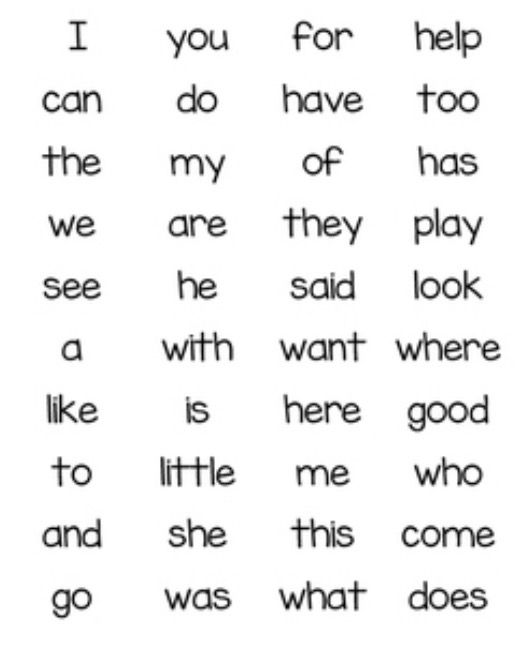 Flash Words are different from other decodable words only because of their frequency. They are called Flash Words because students will need lots of practice to read and spell these words “in a Flash”. These are called “Flash Words” instead of “sight words” because students do not have to memorize any part of Flash Words. They can use their knowledge of phonics patterns to read and spell the words.
Flash Words are different from other decodable words only because of their frequency. They are called Flash Words because students will need lots of practice to read and spell these words “in a Flash”. These are called “Flash Words” instead of “sight words” because students do not have to memorize any part of Flash Words. They can use their knowledge of phonics patterns to read and spell the words.
Flash Words with advanced vowels to teach with early phonics instruction
Table 2B shows 60 one-syllable words with more advanced vowel spelling patterns. A few of these are so frequent that they will need to be taught when students are still learning the short vowel spelling patterns (VC and CVC) during phonics lessons.
Table 2B: Flash Words (Decodable Words)
60 One-Syllable Words With R‐Controlled, Long, and Other Vowel Spellings
(Numbers in parentheses are the Dolch Frequency Ranking)
| r-Controlled Vowels | CV Long Vowel | VCe (silent e) | Vowel Teams with Long Vowel Sounds | Vowel Teams with Other Vowel Sounds |
|---|---|---|---|---|
| (Sorted by vowel spelling) | (Sorted by vowel spelling) | (Sorted by vowel spelling) | (Sorted by vowel sound, then vowel spelling) | (Sorted by vowel sound, then vowel spelling) |
| for* (16) | I* (6) | came (69) | play (127) | out* (31) |
| or* (123) | he* (4) | take (94) | may (130) | round (140) |
| start (150) | she* (15) | make (114) | say* (183) | found (200) |
| far (205) | be* (33) | made (162) | see* (48) | down* (40) |
| her* (28) | we* (36) | gave (164) | green (99) | now* (66) |
| first (146) | me* (58) | ate (177) | sleep (116) | how* (88) |
| hurt (186) | go* (35) | like (53) | keep (143) | brown (117) |
| so* (47) | ride (76) | three (170) | look (26) | |
| no* (68) | five (119) | eat (125) | good (82) | |
| my* (56) | white (152) | read (197) | new (148) | |
| by* (103) | clean (208) | soon (161) | ||
| fly (138) | right (90) | draw (207) | ||
| try* (147) | light (184) | saw* (106) | ||
| why (198) | own (199) | |||
| show (202) | ||||
| grow (209) |
* Many programs teach these words as Heart Words when students are still learning to read words with short vowels.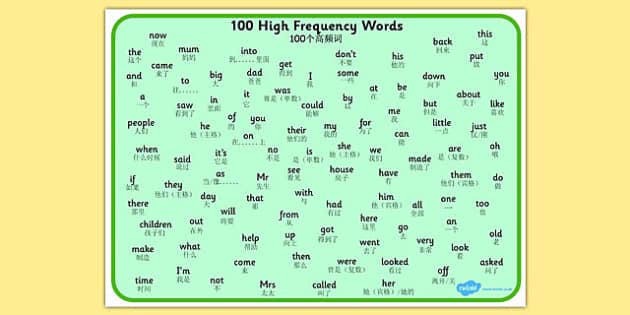
Traditionally, many words in Table 2B would be taught as “sight words” and not included as part of phonics lessons. These words might be introduced as they are encountered in a story, or they might be taught in order. For example, he would be taught as high-frequency word #4, then she taught as high-frequency word #12, with we (#26), be (#33), and me (#58), following later.
Under the new model, words with asterisks in Table 2B are still introduced when short vowels are being taught. The difference in the new model is that these words are grouped together by vowel spelling pattern to make it easier for students to remember the words. Instead of teaching he in isolation as a word to be memorized, we teach he, be, we, me, and she together (as shown in the CV column in Table 2b) and point out that the letter e spells the long e sound. Go, no, and so can be taught together, as can my, by, and why.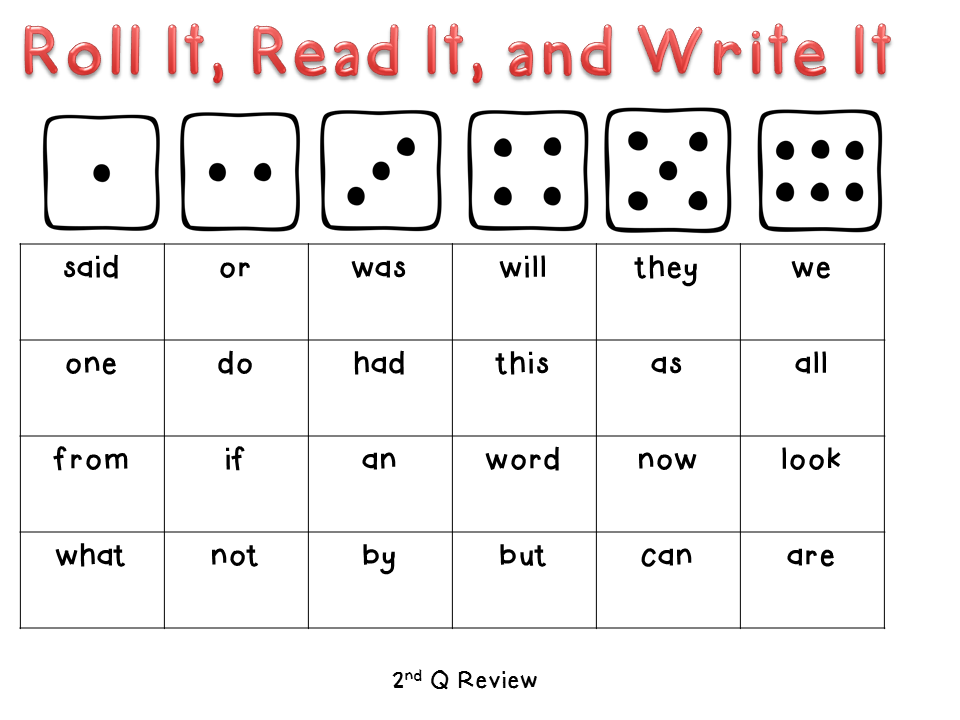
Students will learn words more easily when grouped together by similar spelling than by memorizing words one at a time as whole units. If the curriculum requires a Flash Word to be taught before the vowel pattern has been introduced, teachers can refer to Table 2B to find words that can be grouped together.
Flash Words with two and three syllables
Table 2C shows 16 Flash Words with two syllables and one Flash Word with three syllables. We recommend teaching these words after students have learned to read two‐syllable words in phonics instruction. If these words must be introduced earlier, students will learn them more easily if the teacher breaks the words into syllables and shows any known letter sounds in each syllable. This way students learn to read each syllable and blend the syllables into a word, instead of having to memorize the whole word.
Table 2C: Flash Words (Decodable Words)
17 Two-Syllable Words and 1 Three-Syllable Word
(Numbers in parentheses are the Dolch Frequency Ranking)
| CVC | "A" Spells Schwa in First Syllable | Short Vowels and r-Controlled Vowels | Short Vowel and Long Vowel | All Other Two-Syllable Words | Three-Syllable Word |
|---|---|---|---|---|---|
| seven* (134) | about* (84) | after (108) | myself (139) | little (39) | every** (96) |
| upon (211) | around* (85) | never (133) | open* (165) | over (73) | |
| away* (101) | better (172) | funny (175) | going (115) | ||
| under (196) | yellow 118) | ||||
| before (124) |
* These words have a schwa sound in the first or second syllable.
** This word is often pronounced with two syllables, especially in conversation.
Heart Words
The Dolch 220 List has 82 Heart Words (37%) that are shown on Tables 3A and 3B. Heart Words have Heart Letters, which are the irregularly spelled part of the word. For example, o is the Heart Letter in the words to and do.
Some of the Dolch Heart Words with similar spelling patterns can be grouped together, even though the spelling patterns are not regular. Table 3A (on the next page) shows 45 Heart Words grouped according to similar spelling patterns. The table also lists twelve words not on the Dolch List. These twelve words have similar spelling patterns to the Dolch words listed, and the words are likely to be words already in young students’ vocabularies. For example, could and would are Dolch words. We recommend adding should when could and would are taught, even though it is not on the Dolch 220 List.
The groups of words in Table 3A can be added to any phonics or spelling lesson, with the Heart Letters pointed out. For example, the words his, is, as, and has can all be taught as vc and cvc words in which the letter s is the Heart Letter because it spells the sound /z/.
For example, the words his, is, as, and has can all be taught as vc and cvc words in which the letter s is the Heart Letter because it spells the sound /z/.
Table 3A: Heart Words
59 Words Grouped by Similar Spelling Patterns
45 Words from the Dolch List and 14 Not on the Dolch List
(Numbers in Parentheses Are the Dolch Frequency Ranking)
(Diamond [♦] indicates word is not on the Dolch List, but it fits the spelling pattern)
| Unusual Spelling Pattern | High-Frequency Words |
|---|---|
| s at the end of the word spells /z/ | his (13), is (27), as (32), has (166) |
| v is followed by e because no English word ends in v | have (34), give (144), live (206) |
| o-e spells short u /ŭ/ | some (30), come (64), done (180) |
| o spells /ōō/ (as in boot) | to (2), do (41), into (77) |
| rhyming words spelled with the same last four letters | there (29), where (95) |
| s spells /z/ in a vce word | those (179), these (212) |
| all spells /ŏll/ | all (25), call (167), fall (193), small (195), ball ♦ |
| oul spells /ŏŏ/ (as in cook) | could (43), would (57), should ♦ |
| e at the end is after a phonetic r-controlled spelling | were (50), are (63) |
| vcc and cvcc words with o spelling long o /ō/ | old (102), cold (136), hold (173), both (190) |
| cvcc words with i spelling long i /ī/ | find (167), kind (189), mind ♦ |
| words similar in meaning and spelling | one (54), once (160) |
| a after w sometimes spells short o /ŏ/ | want (86), wash (201), watch ♦ |
| ue spells /ōō/ as in boot | blue (79), glue ♦, clue ♦, true ♦ |
| u spells /ŏŏ/ (as in cook) | put (91), full (178), pull (187), push ♦ |
| rhyming words with silent l | walk (121), talk ♦ |
| rhyming words - the letter a spells short i or short e (depending on dialect) | any (83), many (218) |
| oo at the end of a word spells /ōō/ (as in boot) | too (92), boo ♦, moo ♦ |
| or spells /er/ | work (145), word ♦, world ♦ |
| uy spells long i /ī/ | buy (174), guy ♦ |
Teaching Heart Words
Table 3B shows 37 Heart Words not easily grouped by spelling patterns.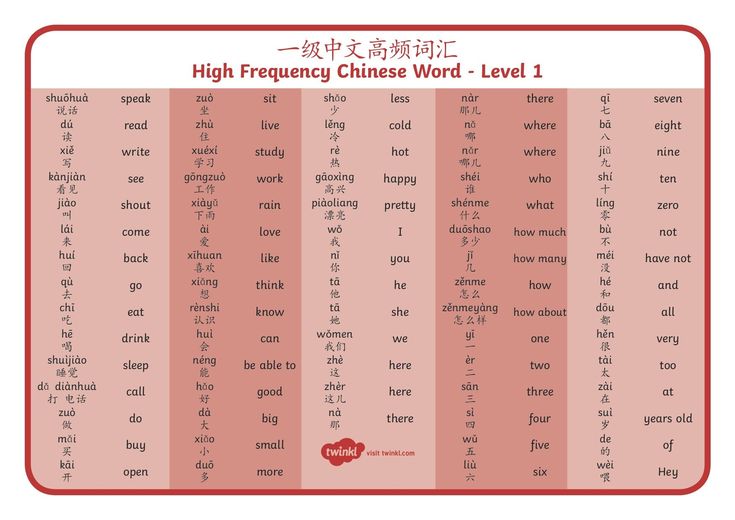 Most of the words are more difficult for spelling than for reading.
Most of the words are more difficult for spelling than for reading.
As with all Heart Words, these words can also be incorporated into phonics instruction when students learn to read the regularly spelled letters a word. For example, when students know the digraph th, they and their can be introduced. The digraph th in both these Heart Words is a regular spelling for the sound /th/. The Heart Letters are ey in they and eir in their. Similarly, the Heart Letter in the word what is a, and the Heart Letter in the word from is o.
Table 3B: Heart Words
37 Words that Do Not Fit into Spelling Patterns
(Numbers in parentheses are the Dolch Frequency Ranking)
| the (1) | very (71) | here (105) | does (154) | use (181) |
| a (5) | yours (74) | two (122) | goes (156) | carry (194) |
| of (9) | from (81) | again (126) | write (157) | because (204) |
| you (7) | don’t (87) | who (128) | always (158) | together (214) |
| was (11) | know (89) | been (129) | only (168) | please (215) |
| said (12) | pretty (97) | eight (135) | our (171) | shall (219) |
| they (18) | four (100) | today (137) | warm (176) | laugh (220) |
| what (46) | their (104) |
Students enjoy drawing a heart above Heart Letters, and the hearts help them remember the irregular spellings.
For example, in the word said, the hearts would go above ai because those letters are an unexpected spelling for short e (/ĕ/). A student’s practice card for the word said is shown at the right.
Implementing the new model
In order to implement the new phonics-based model for teaching high-frequency words, teachers will need to fit high-frequency words into phonics instruction. To do this, generally a committee of three or four kindergarten and first grade teachers organizes their lists of high-frequency words according to Heart Words and Flash Words by spelling patterns. Next they determine when and how high-frequency words fit into the phonics scope and sequence. These same teachers provide professional development to show other teachers how to implement the new model.
Sometimes a coordinated effort to change the way high-frequency words are taught is not an option, and teachers are able to only partially implement the suggestions in this article.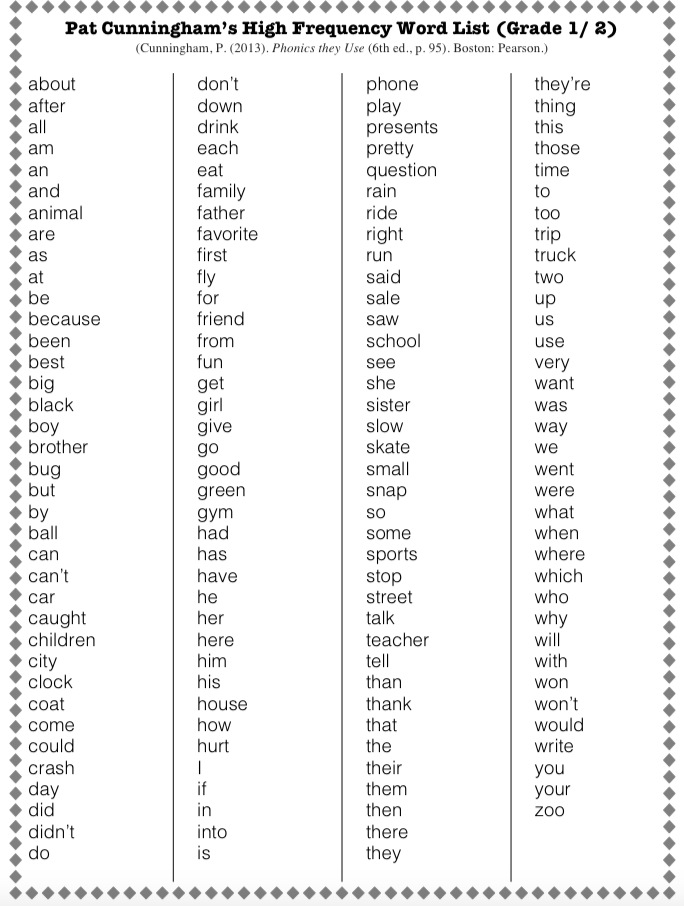 These teachers continue to introduce the words as determined by their curriculum. However, they tell students whether the “sight word” is a Flash Word or a Heart Word, and they introduce the words by teaching letter–sound relationships as outlined in this article. Further, teachers introduce words with similar spelling patterns whenever possible. For example, if only the word would is scheduled to be introduced, they also teach could and should, which fit the spelling pattern. Finally, these teachers do not hold students accountable for high-frequency words that are beyond the spelling patterns that have been taught in phonics lessons.
These teachers continue to introduce the words as determined by their curriculum. However, they tell students whether the “sight word” is a Flash Word or a Heart Word, and they introduce the words by teaching letter–sound relationships as outlined in this article. Further, teachers introduce words with similar spelling patterns whenever possible. For example, if only the word would is scheduled to be introduced, they also teach could and should, which fit the spelling pattern. Finally, these teachers do not hold students accountable for high-frequency words that are beyond the spelling patterns that have been taught in phonics lessons.
The new model allows a different approach for working with students who have difficulty learning high-frequency words. For example, students working on short vowel patterns may confuse her and here, which are often introduced early as part of the “sight word” list. A teacher who recognizes the source of this confusion would not expect students to continue trying to memorize the two words. Instead, the teacher would include her as part of instruction on r-controlled vowels and include here when silent e is taught. Students will be less likely to misread or misspell these words when they understand the relation of the spelling er to the sound /er/ and the spelling ere to the sound /ēr/.
Instead, the teacher would include her as part of instruction on r-controlled vowels and include here when silent e is taught. Students will be less likely to misread or misspell these words when they understand the relation of the spelling er to the sound /er/ and the spelling ere to the sound /ēr/.
Traditionally, students would have continued struggling with and failing to memorize these easily confused words. With the new model, those students are not held accountable for accurately reading and spelling the words until they can understand and use the sound–spelling correspondences. All teachers using this approach say that students learn to spell and read the words much more easily than with the traditional approach.
About the authors
Linda Farrell and Michael Hunter are founding partners of Readsters, LLC. They provide professional development and write curriculum to support excellent reading instruction to students of all ages.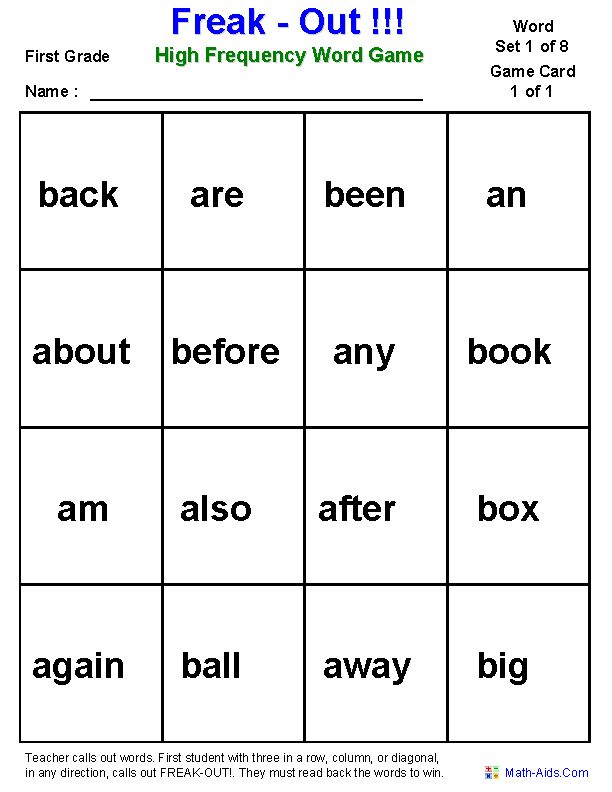 Their favorite work is in the classroom where they can model effective reading instruction and coach teachers. Their most unusual work so far has been helping develop early reading instruction for children in Africa who are learning to read in 12 different mother tongue languages that Linda and Michael don’t even speak.
Their favorite work is in the classroom where they can model effective reading instruction and coach teachers. Their most unusual work so far has been helping develop early reading instruction for children in Africa who are learning to read in 12 different mother tongue languages that Linda and Michael don’t even speak.
Tina Osenga was a founding partner at Readsters, and she is now retired.
What Are High-Frequency Words? | A Guide For Parents
You want your child to become a confident reader. One of the best ways to do that is to help them learn high-frequency words. These words are the ones your child will see in nearly every book they open.
Because they’re so common, high-frequency words provide the building blocks for children’s reading success. Learning to recognize these words quickly and automatically is an important step in becoming a fluent reader.
There are many ways you can help your child master these words. But first, you have to know what they are.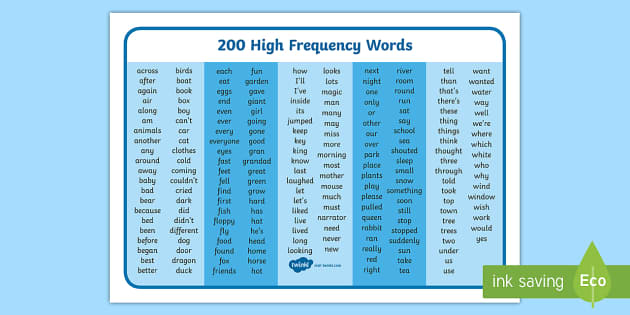
What Are High-Frequency Words?
Back in the 1930s, Dr. Edward William Dolch started studying how children learn to read. He found that certain words make up a high percentage of the text found in books for young readers.
Using his research, Dolch compiled a list of 220 words that were used most frequently in children’s books. He also created a list of 95 common nouns. Between the two lists, there are 315 words.
Dolch believed that if a child mastered those words by the end of third grade, they would be able to read proficiently. Though Dolch wrote his list long before your child was born, it’s not out of date.
Subsequent studies have shown that these words continue to make up most words in children’s books. Today, teachers and reading specialists refer to Dolch’s list of words as “high-frequency” or “sight” words.
To become a good reader, your child needs to know these words by sight, meaning they shouldn’t need to stop and sound them out. And the best way for that to happen is through lots of practice.
Which Words Are Considered High-Frequency?
Before your child can practice, you need to know what words to work on. The main 220 high-frequency words are broken down by grade level. Here are a handful of the words you’ll find on each:
Pre-K
- Away
- Find
- Said
- The
- You
Kindergarten
- Are
- New
- That
- With
- Yes
First Grade
- Again
- From
- Of
- Then
- Walk
Second Grade
- Because
- Does
- Goes
- Read
- Would
Third Grade
- About
- Draw
- Laugh
- Together
- Light
There’s also a list of 95 high-frequency nouns. Here are some of those words:
- Apple
- Birthday
- Children
- Flower
- Robin
- Stick
As you can see, these words are ones your child is likely to encounter many times in different types of children’s books.
Why Are Sight Words Important?
Sight words are important for children to master. But why do they take so much practice?
First, many of these words can’t be sounded out using the traditional phonetic rules. Words such as the, said, and again are rule-breakers. If your child doesn’t know what these words say, they’ll get stuck on them while reading.
Also, being able to read high-frequency words without decoding them allows your child to read more quickly. That makes reading more enjoyable and helps your child feel confident in their reading abilities.
Finally, when your child doesn’t have to stop to sound out words while they’re reading, their brain can focus on the meaning of the words instead. And that deepens their comprehension.
How To Help Your Child Master High-Frequency Words
Now that you know what high-frequency words are and why they’re so important, here are some practical ways to help your child master them.
1) Make Learning Fun
Learning to read doesn’t have to be boring.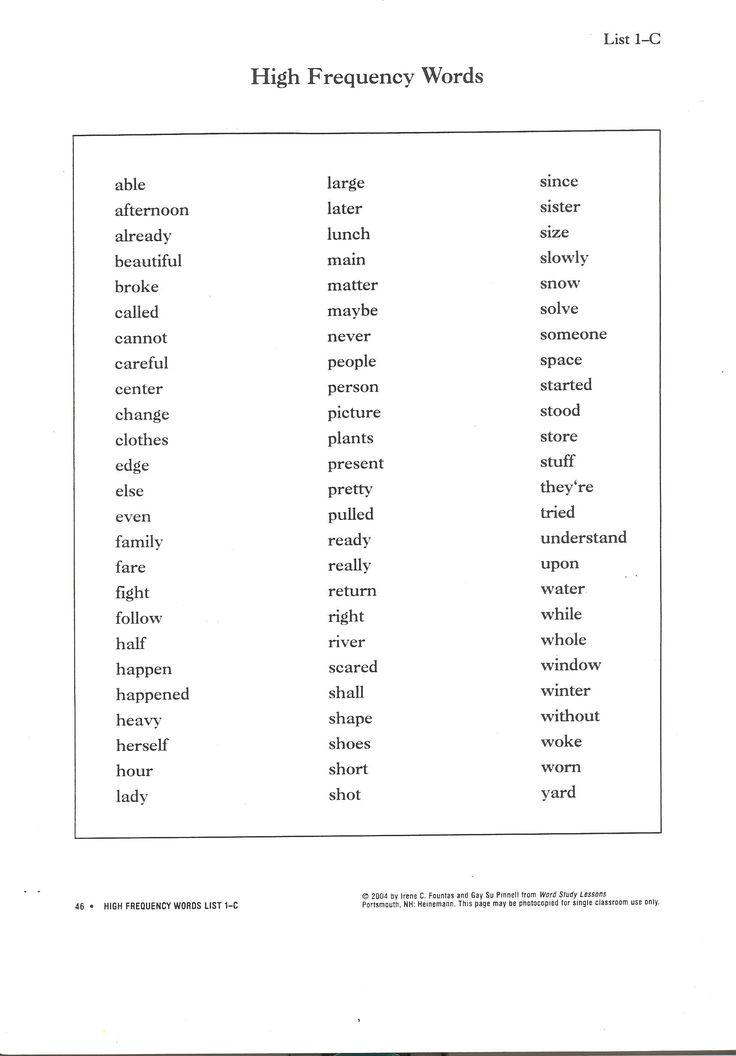 When working with your child, steer clear of mindless drills or never-ending flashcard sessions.
When working with your child, steer clear of mindless drills or never-ending flashcard sessions.
Instead, look for ways to make learning more enjoyable. For example, pick engaging sight word activities that allow your child to practice what they’re learning without making them miserable.
You can accomplish a lot in just a couple of minutes throughout the day. If you’re looking for a quick way to make reviewing sight words part of your daily routine, give this activity a try.
First, put some index cards in a file box so they’re easily accessible. Then, take five index cards, choose 5 sight words, and write one on each card. These are the words you’re going to work on right now.
Each day, have your child read those five cards. If they read a word correctly and instantly, put a checkmark on it. When a card has three checkmarks, move it to the back of the box. Then, add a new word into the mix.
Once there are ten cards in the back, add a weekly review session into your routine. Go through the mastered words quickly once a week. Any word your child has forgotten (which is totally normal) goes back to the front of the box. Add them back in as a part of your daily five.
Go through the mastered words quickly once a week. Any word your child has forgotten (which is totally normal) goes back to the front of the box. Add them back in as a part of your daily five.
2) Read Together
It’s important to model good reading for your child. One of the best ways to do this is to spend time reading together every day. When you sit down to read with them, stop to point out the high-frequency words that pop up in the text.
As your child starts recognizing these words, pause when you come to one. Then, ask them to read the word you stopped on.
This activity helps your child become familiar with the words and how they look in context. It also allows you to gauge their understanding of the words. If your child is having trouble reading a certain word, you know it’s one you need to focus on.
3) Go On Word Hunts
You want your child to understand that sight words are everywhere. One way you can do that is by having them go on word hunts.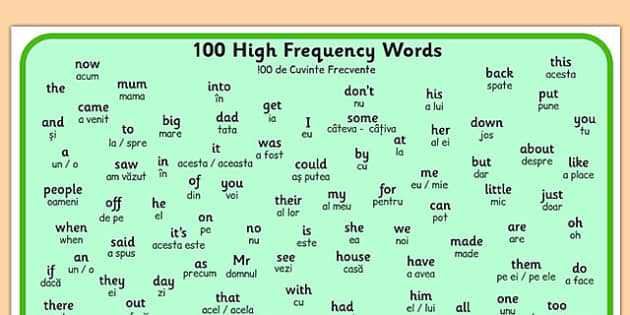
If you’re out and about, ask them to keep their eyes peeled for high-frequency words. Encourage them to look at signs for words they can read. When they find one, offer plenty of praise for their discovery.
You can also give your child a newspaper or magazine and a pen. Ask them to look through the words and circle the sight words they know. Once they’re done, count the circled words together. Point out how often these words are used.
Your child can also practice searching for sight words with the HOMER app, where you’ll find a variety of sight word games and activities to help them master high-frequency words.
As they play Sight Word Memory or Soak And Sort Sight Words, they’ll be learning to read these words. And since the app creates a personalized learning environment, your child can get started no matter what reading level they are at.
While they play, the HOMER learning journey can gently guide them along the path to becoming better readers.
4) Make Word Soup
Don’t worry. There’s no cooking involved in this game. Instead, your child will be stirring together a pot full of sight words.
There’s no cooking involved in this game. Instead, your child will be stirring together a pot full of sight words.
To play, write some sight words on index cards. Write one word on each card in large letters so it’s easier for your child to read. Then, get out a big soup pot and a large spoon.
When you have your materials gathered, hide five index cards around the room. Then, call your child over. Ask them to find the cards and add them to your soup pot.
As they find each word, have them read it aloud, dump it into the pot, and give it a stir with the spoon.
When all the cards have been added to the soup, use the spoon to fish out a word. Hand it to your child and ask them to read it. Continue scooping out words until they’ve read them all again.
5) Practice Spelling High-Frequency Words
Spelling and reading go hand in hand. To help your child improve their reading skills, help them learn to spell high-frequency words.
To make it fun, connect spelling with physical or hands-on activities.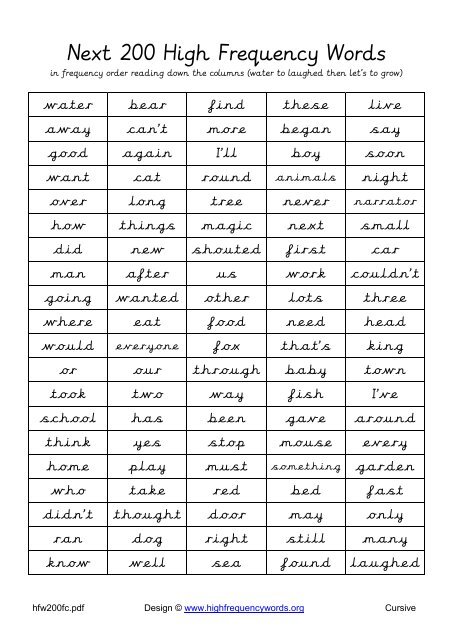 For example, ask them to jump up and down while spelling the word the. As they jump, they can say “T, h, e spells the.” You can also have them skip, run, crawl, or do jumping jacks as they spell.
For example, ask them to jump up and down while spelling the word the. As they jump, they can say “T, h, e spells the.” You can also have them skip, run, crawl, or do jumping jacks as they spell.
Manipulatives such as Scrabble blocks or letter tiles are another fun way to practice spelling. Ask your child to use the letters to spell a word you call out. Once they spell the word correctly, have them read it to you.
Be Your Child’s Reading Coach
With just a little practice each day, you can help your child improve their reading skills. As you coach your child in mastering high-frequency words, you’ll be setting them up for reading success.
To make learning these words even more fun, let them play with the HOMER Learn and Grow app. It will help your child practice sight words through engaging activities. And as they practice regularly, they’ll become an even better reader!
Author
Key requests.
 Word frequency: high and low frequencies
Word frequency: high and low frequencies October 23, 2015
SEO basics Algorithms
Search engines have classified keywords to more accurately show what the user expects to see in search results for them.
Main types of keywords (queries)
-
Informational
Such keywords are written in a query to learn something new or get specific information. The main criterion for the user with such a request is the usefulness and information content of the site. As an example, such requests include the questions "mobile phone device", "how to replace the lock".
-
Navigation
These queries are for searching for a specific site or place. Most often, users do not immediately enter the domain address, but indicate the name of the site. For example, "where is the Volga", "head office of company A".
-
General
Such requests do not have a specific topic, and in this case search engines provide the most diverse information.
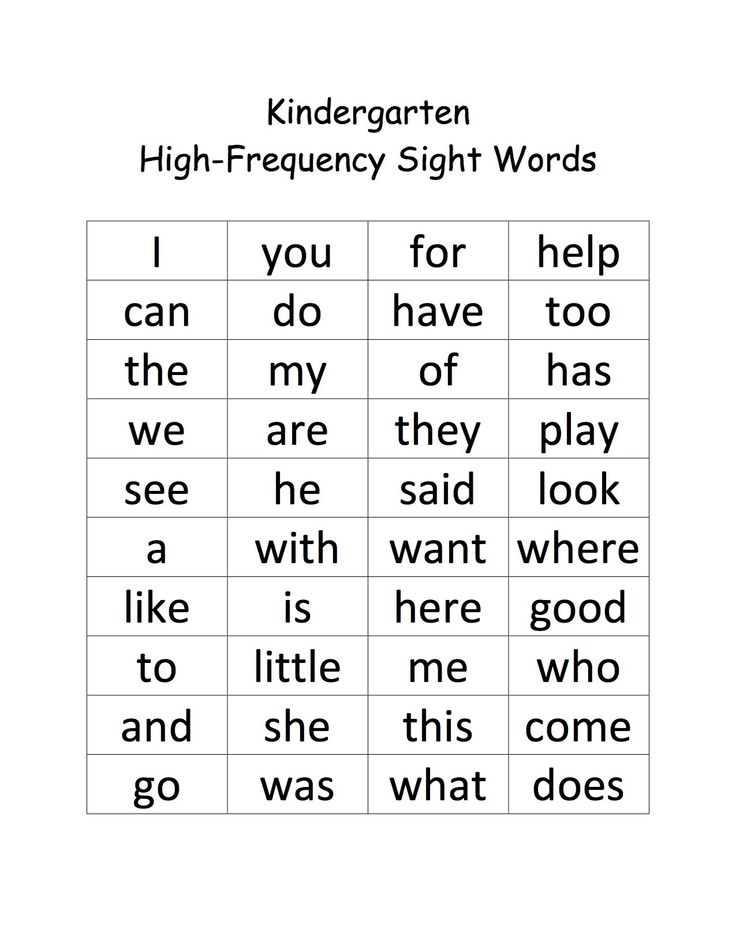 This type includes requests consisting of one or two words, for example, "airplane", "children's shoes". Search engines do not know exactly what users are looking for for these queries and therefore they try to give the widest range of possible sites in the results - these are directories, portals, and online stores.
This type includes requests consisting of one or two words, for example, "airplane", "children's shoes". Search engines do not know exactly what users are looking for for these queries and therefore they try to give the widest range of possible sites in the results - these are directories, portals, and online stores. -
Transactional
In this case, the user wants to perform a specific action. For example, buy, sell, download, etc. Such requests are most important for online stores and sites that provide any services. For transactional queries, search engines place increased demands on the functionality of the site. For example, with the word "buy" at the beginning of the search results, there will be sites that really allow you to buy or order a product.
-
Commercial
These requests partially overlap with transactional requests and attract the bulk of buyers to the site. They look like "price for an Audi A8", "order flowers".
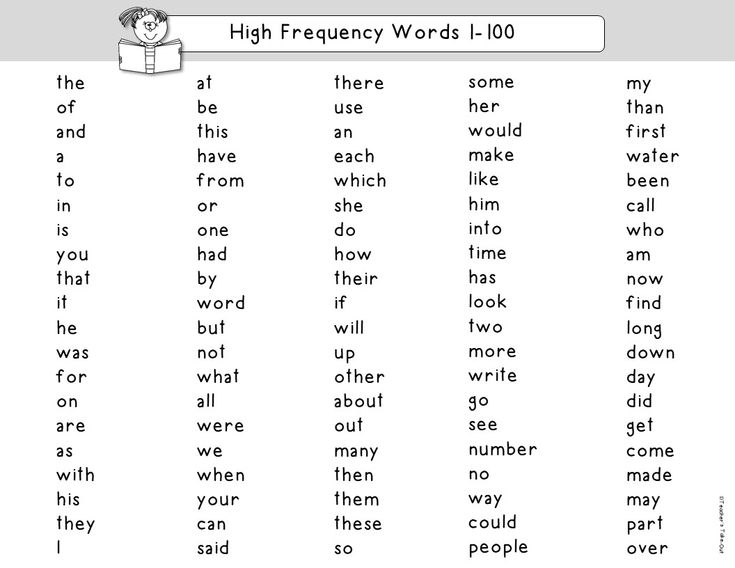
-
Geo-dependent
That is, queries that refer to a certain region. For example, if a user needs dry cleaning, the search engine will return relevant sites in a given city or even district (for devices with geolocation). The search engine automatically determines by keywords that the user only needs local sites for this query. She knows this based on the preservation of history: if the vast majority of users eventually go to local sites, the request is geo-dependent.
Keywords can have several features that do not contradict each other. For example, they can be both commercial and transactional at the same time.
Frequency of queries
Also, keywords can be classified by frequency, i.e., by the frequency of the query in the search engine:
- High-frequency (HF) - the most popular queries;
- Low-frequency (LF) - rarely used by users, but quite specifically defining the subject;
- Midrange (MF) .

Optimizers do not set precise boundaries between these groups. Rather, these terms appeared to simplify communication between optimizers. It is conditionally believed that regional low-frequency requests have from 1 to 300 - 500 impressions per month, mid-range requests - from 300 to 3000 - 7000 impressions, high-frequency requests, respectively, more. Search engines perceive these groups differently. For example, for low-frequency queries, they have to accumulate statistics of behavioral characteristics for a long time, since there are few transitions, and therefore, to calculate the ranking, behavioral factors are used not for the keyword, but for the entire site. With high-frequency queries, everything is more complicated, as a rule, they consist of one or two words, so there are a lot of suitable pages on the Internet and on a particular site. This complicates the process of ranking (sorting) to display only the best results.
To promote new sites, it is more profitable to use low-frequency queries.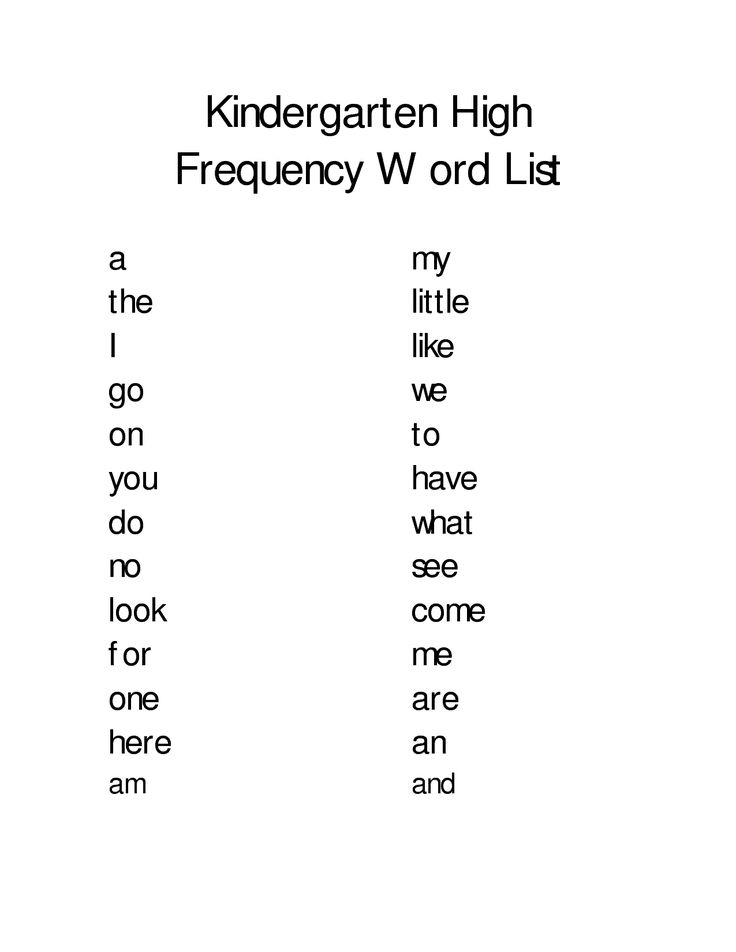 There is less competition for them and they are the most specific. High-frequency requests are the most expensive, and promotion on them makes sense only after entering the TOP-10 LF and MF requests. At the same time, high-frequency requests are characterized by low conversion, i.e., a small number of applications for services in relation to the total number of visits. The reason is simple - when searching for “barbell”, they can search for a sports bar to buy, a photo of a drill bar, a clothes bar or a bath bar. But “iron Samsung 2410 blue buy”, most likely, they will be looking to buy directly. HF queries can be used about a year after the site appeared, or earlier if MF queries began to appear in the TOP-10.
There is less competition for them and they are the most specific. High-frequency requests are the most expensive, and promotion on them makes sense only after entering the TOP-10 LF and MF requests. At the same time, high-frequency requests are characterized by low conversion, i.e., a small number of applications for services in relation to the total number of visits. The reason is simple - when searching for “barbell”, they can search for a sports bar to buy, a photo of a drill bar, a clothes bar or a bath bar. But “iron Samsung 2410 blue buy”, most likely, they will be looking to buy directly. HF queries can be used about a year after the site appeared, or earlier if MF queries began to appear in the TOP-10.
In general, you should first compile a rough list of keywords that are relevant to your site. Relevance to the topic in this matter is very important, especially for commercial inquiries. Getting to the TOP due to popular keywords will not provide profit if the user does not find the necessary information on the site.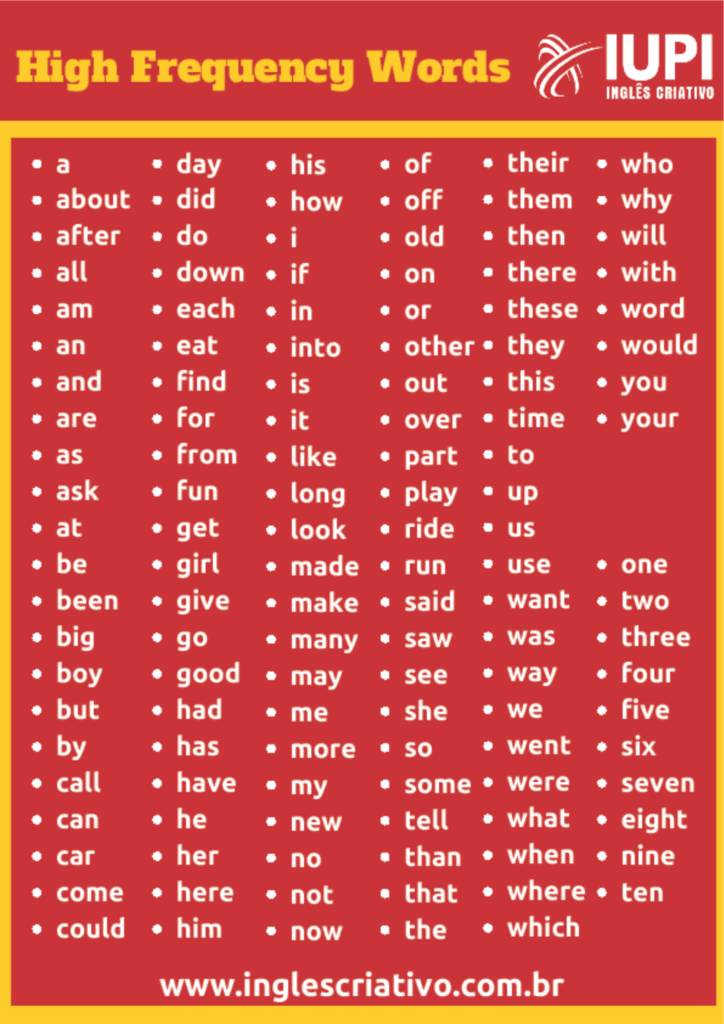 After identifying with possible keywords, it is necessary to check their frequency and competitiveness. These are the most important indicators and, of course, everyone wants to find a popular query with little competition in order to immediately go to the TOP.
After identifying with possible keywords, it is necessary to check their frequency and competitiveness. These are the most important indicators and, of course, everyone wants to find a popular query with little competition in order to immediately go to the TOP.
Query Concurrency
Concurrency is a bit more complicated. Several methods can be used to determine the number of competitors.
- In the Google search box, type allintitle: "key phrase" ("key phrase" must be replaced with the query of interest). The search engine will return all pages that contain the given query in their titles. This approach is justified by the fact that if the keyword is indicated in the title itself, then the site is definitely optimized for this request. By the number of results given, i.e. competitors, you can determine the degree of competition.
- You can analyze the search results for the desired query. If aggregators and old large sites are in the first positions, then the competition is clearly high.
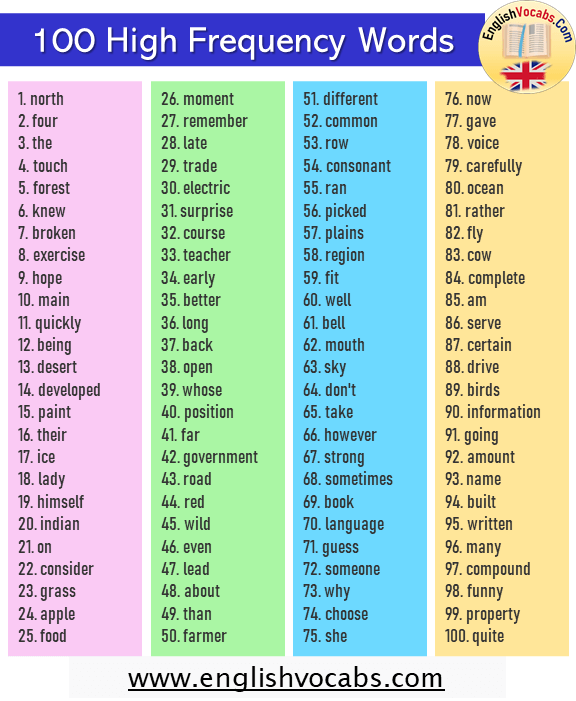
- The more contextual advertising is bought and the more expensive it is, the more difficult it is to break into the TOP.
How to learn words so that they are not forgotten? – English with Experts
Hello everyone!
Today's post is about a burning issue for foreign language learners, namely:
“How to learn words so that they are not forgotten the next day or week?”
Here are 4 tips from my personal (successful) experience in learning English.
Tip 1: Choose high frequency words.
It makes no sense to waste time learning exotic words and expressions that you are unlikely to use when communicating. It is smarter to learn high-frequency words.
“Well, well,” you say, “But how to recognize these high-frequency words? After all, if I don’t know the word, how will I know if it is high-frequency or not?” Logical question. Below is the solution.
Tip 1: See if your new word is on the list of high frequency words.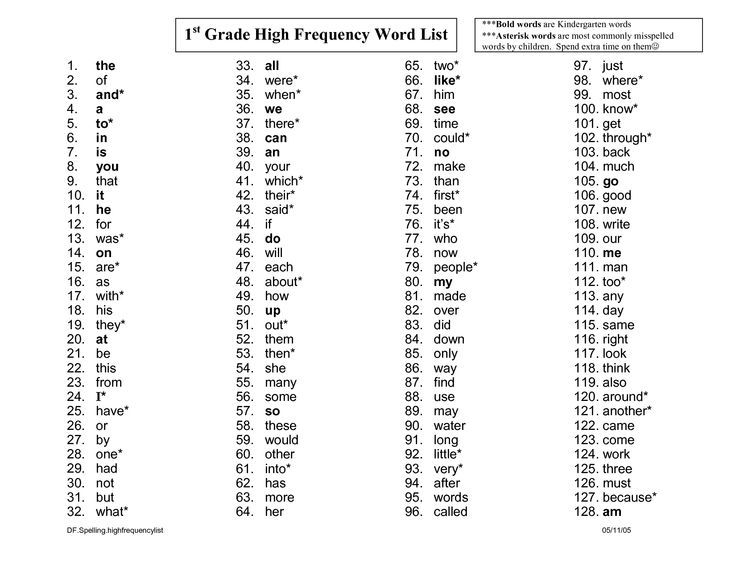 Where?
Where?
You can here.
This is a list of the most frequent words in English. Feel free to download and use (Do you remember about Ctl + F, which helps to search for a word in a document?)
Tip 2: Choose words from adapted materials.
Although some people think that you can immediately learn a language from non-adapted (authentic) materials, I do not agree with them, because students often lose heart from non-adapted literature. Too difficult! A sea of new words! Familiar feelings? If so, then it would be better for you to take adapted materials.
You can start with books like Penguin or materials like Voice of America that have been adapted for language learners. These materials contain only ‘selected’ words and expressions and you will not waste time on rare and intricate phrases for which you are not yet ready.
If you study with a teacher, he will help you select high-frequency phrases.
Tip 2: Learn words only in context - never learn a ‘lonely’ word
Why? (i) To better remember and (ii) use the word correctly in the future.
Our memory is arranged in such a way that we remember phrases and situations better than individual words, since situations create more vivid images and associations. Take advantage of this and surround the word with context.
How?
Tip 1: Copy a sentence or part of a sentence so that the words are not left alone, i.e. by themselves.
Tip 2: Type a word or expression into google.co.uk or google.com.au and look through several search results. For what? You will see in what situations your word or expression is used and remember it much better. Scientists call this breadth and depth of memory.
In other words, the more different situations you see with a particular word, the better you will remember that word.
There is an opinion that a word must be encountered at least 9 times in different situations in order to remember it. I also heard that 7 'meetings' might be enough. The number of “meetings” with a word before you finally remember it will depend on various factors, for example, on your memory, time of day, whether you drank your morning coffee . .. etc. In any case, the verdict is obvious: the word must be seen in different situations, but how many times is how lucky.
.. etc. In any case, the verdict is obvious: the word must be seen in different situations, but how many times is how lucky.
Another option for finding situations: You can use the corpus (rather than a search engine).
2 most popular cases. British English Corps and American English Corps.
You can put a word into a corpus (use of the corpus is free) and look at 7-10 situations with your word. After that, your word will be remembered much faster.
Tip 3: Come up with bright, absurd associations with new words.
Yes, bright and absurd.
The more unusual (and possibly indecent) your association is, the better you will remember the new word.
Why? This is how our memory works.
All new information fits into the existing memory infrastructure and is linked to other information by 'bridges'. The more bridges, the better. And bright and unusual situations create stronger 'bridges'.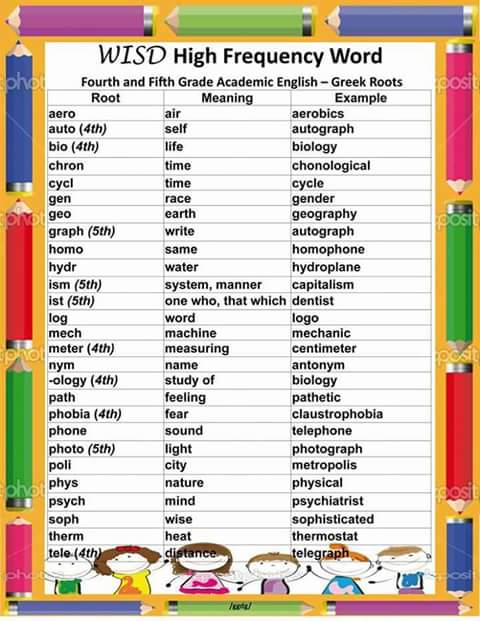
Tip 4: Consider forgetting cycles and optimize repetition.
Every day we read, hear, see a huge amount of information. If we memorized everything that comes across to us, then our head would probably explode ...
Our brain has learned to clean itself from information. Therefore, every day our brain makes a 'revision' of information and throws out 'unnecessary'. What is it based on? Mostly on when it (the brain) saw the information for the last time.
Cycles of forgetting are more or less defined by scientists. It is said that we forget the most on the first day after learning new information. The next wave of cleaning comes on the 2nd day. Then on the 4th and 7th days.
What does this mean?
Repetitions should be carried out just on these days, namely on days 1, 2, 4 and 7, when you are most likely to forget these new words. Moreover, on the first day it is advisable to repeat a couple of times, since this is the most ‘risky’ day.